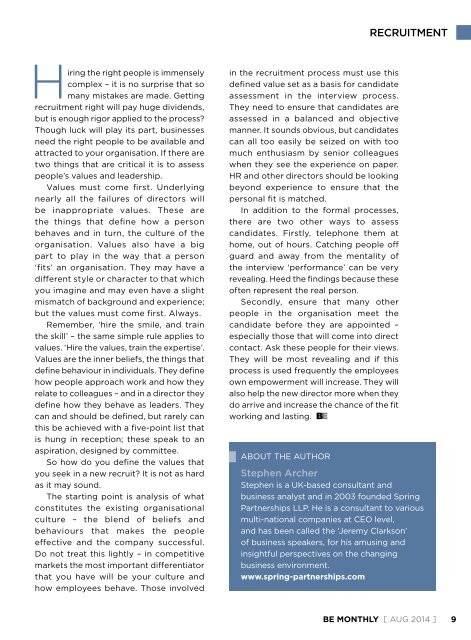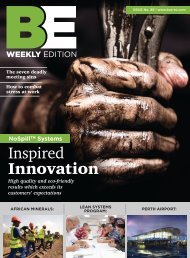Nickel in demand
You also want an ePaper? Increase the reach of your titles
YUMPU automatically turns print PDFs into web optimized ePapers that Google loves.
Recruitment<br />
Hir<strong>in</strong>g the right people is immensely<br />
complex – it is no surprise that so<br />
many mistakes are made. Gett<strong>in</strong>g<br />
recruitment right will pay huge dividends,<br />
but is enough rigor applied to the process?<br />
Though luck will play its part, bus<strong>in</strong>esses<br />
need the right people to be available and<br />
attracted to your organisation. If there are<br />
two th<strong>in</strong>gs that are critical it is to assess<br />
people’s values and leadership.<br />
Values must come first. Underly<strong>in</strong>g<br />
nearly all the failures of directors will<br />
be <strong>in</strong>appropriate values. These are<br />
the th<strong>in</strong>gs that def<strong>in</strong>e how a person<br />
behaves and <strong>in</strong> turn, the culture of the<br />
organisation. Values also have a big<br />
part to play <strong>in</strong> the way that a person<br />
‘fits’ an organisation. They may have a<br />
different style or character to that which<br />
you imag<strong>in</strong>e and may even have a slight<br />
mismatch of background and experience;<br />
but the values must come first. Always.<br />
Remember, ‘hire the smile, and tra<strong>in</strong><br />
the skill’ – the same simple rule applies to<br />
values. ‘Hire the values, tra<strong>in</strong> the expertise’.<br />
Values are the <strong>in</strong>ner beliefs, the th<strong>in</strong>gs that<br />
def<strong>in</strong>e behaviour <strong>in</strong> <strong>in</strong>dividuals. They def<strong>in</strong>e<br />
how people approach work and how they<br />
relate to colleagues – and <strong>in</strong> a director they<br />
def<strong>in</strong>e how they behave as leaders. They<br />
can and should be def<strong>in</strong>ed, but rarely can<br />
this be achieved with a five-po<strong>in</strong>t list that<br />
is hung <strong>in</strong> reception; these speak to an<br />
aspiration, designed by committee.<br />
So how do you def<strong>in</strong>e the values that<br />
you seek <strong>in</strong> a new recruit? It is not as hard<br />
as it may sound.<br />
The start<strong>in</strong>g po<strong>in</strong>t is analysis of what<br />
constitutes the exist<strong>in</strong>g organisational<br />
culture – the blend of beliefs and<br />
behaviours that makes the people<br />
effective and the company successful.<br />
Do not treat this lightly – <strong>in</strong> competitive<br />
markets the most important differentiator<br />
that you have will be your culture and<br />
how employees behave. Those <strong>in</strong>volved<br />
<strong>in</strong> the recruitment process must use this<br />
def<strong>in</strong>ed value set as a basis for candidate<br />
assessment <strong>in</strong> the <strong>in</strong>terview process.<br />
They need to ensure that candidates are<br />
assessed <strong>in</strong> a balanced and objective<br />
manner. It sounds obvious, but candidates<br />
can all too easily be seized on with too<br />
much enthusiasm by senior colleagues<br />
when they see the experience on paper.<br />
HR and other directors should be look<strong>in</strong>g<br />
beyond experience to ensure that the<br />
personal fit is matched.<br />
In addition to the formal processes,<br />
there are two other ways to assess<br />
candidates. Firstly, telephone them at<br />
home, out of hours. Catch<strong>in</strong>g people off<br />
guard and away from the mentality of<br />
the <strong>in</strong>terview ‘performance’ can be very<br />
reveal<strong>in</strong>g. Heed the f<strong>in</strong>d<strong>in</strong>gs because these<br />
often represent the real person.<br />
Secondly, ensure that many other<br />
people <strong>in</strong> the organisation meet the<br />
candidate before they are appo<strong>in</strong>ted –<br />
especially those that will come <strong>in</strong>to direct<br />
contact. Ask these people for their views.<br />
They will be most reveal<strong>in</strong>g and if this<br />
process is used frequently the employees<br />
own empowerment will <strong>in</strong>crease. They will<br />
also help the new director more when they<br />
do arrive and <strong>in</strong>crease the chance of the fit<br />
work<strong>in</strong>g and last<strong>in</strong>g.<br />
About the author<br />
Stephen Archer<br />
Stephen is a UK-based consultant and<br />
bus<strong>in</strong>ess analyst and <strong>in</strong> 2003 founded Spr<strong>in</strong>g<br />
Partnerships LLP. He is a consultant to various<br />
multi-national companies at CEO level,<br />
and has been called the ‘Jeremy Clarkson’<br />
of bus<strong>in</strong>ess speakers, for his amus<strong>in</strong>g and<br />
<strong>in</strong>sightful perspectives on the chang<strong>in</strong>g<br />
bus<strong>in</strong>ess environment.<br />
www.spr<strong>in</strong>g-partnerships.com<br />
BE Monthly [ Aug 2014 ] 9





